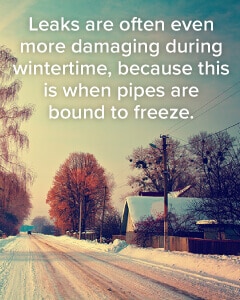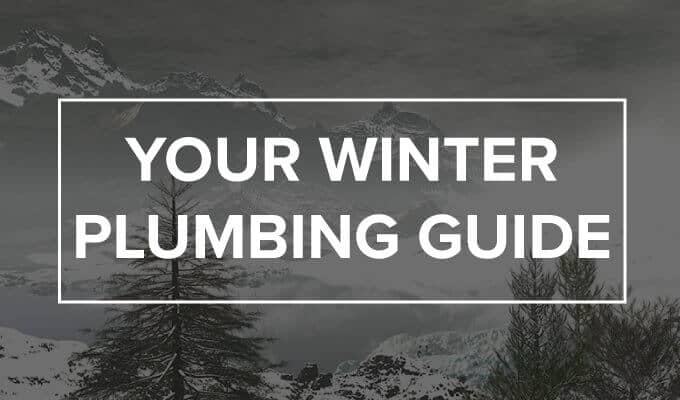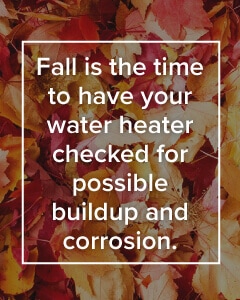When winter hits, plumbing problems skyrocket. According to a 2014 study by the Insurance Information Institute, 22 percent of homeowner insurance claims pertain to damages caused by freezing and water disasters, with an average of $4,024 per claim. Likewise, Google search strings like “plumbing in the winter frozen pipes” are common during the colder months. Therefore, it’s important to arm yourself as a homeowner with the following winter plumbing tips, which can help you reduce the possibility of water-system problems during the holiday season.
Maintain Your Pipes and Drains
Issues with home water systems are often brought on by abuse of the drains. In older homes – where the combination of aged system parts and cold weather can render pipes even more vulnerable – periodic maintenance is especially vital, whether you’re winterizing your house for the cold months or performing spring cleaning. One of the easiest ways to maintain the flow of your drains is to wash the following mixture down your kitchen and bathroom sinks every three or four months:
- 1 cup salt
- 1 cup baking soda
- 1/4 cup cream of tartar
Dissolve the three ingredients in boiling water and equally distribute the solution down your kitchen sink, bathroom sink and bathtub drain. Allow the solution to set for 15 minutes, then wash it down with 2 cups of boiling water in each drain. This should clear away most gunk buildup from the prior few months.
expert plumbing services in central pa
Stop and Prevent Pipe Leaks
When it comes to your home’s pipes, nothing is more troublesome than leaks. A leak can start out subtly and linger for months before spiraling out of hand. Within that time, however, major damage can occur to furniture, carpeting and belongings. If a leak occurs in your basement or crawlspace, you might not even discover the problem until extensive water mold sets in.

- Toilets. When inexplicable wetness forms on the bathroom floor to the side or behind the toilet, it’s possibly the result of leakage. Check the piping to your toilet for any noticeable leaks in the fixture.
- Tubs. A bathtub drain endures lots of water at the end of each shower or bath. Understandably, this causes tremendous pressure that can take its toll over the passage of years. If you have an old-fashioned clawfoot tub, and you see water underneath that isn’t due to overflow or moisture, check the outgoing pipes for signs of possible leaks.
- Showers. Modern homes are often equipped with shower stalls, which are good at containing water and are therefore less messy than traditional tubs. Nonetheless, the piping can get worn, though you might need to check your basement for evidence of leakage from your shower pipes.
- Sinks. Cabinets under sinks are typically used for wastebaskets and cleaning supplies. As such, the cabinet under your kitchen or bathroom sink might not have the most savory smell. In some cases, one of those cabinets could end up smelling much worse that it’s supposed to. This could be due to water mold, which would be the result of a leaky drainpipe. To ensure this doesn’t happen, check the drainpipes to all your sinks every few months for signs of trouble.
Your pipes are less likely to leak if they’re insulated, but this won’t rule out the problem entirely. If you notice signs of leakage despite insulation, feel around the pipes to see if there’s dampness present. This step can also be performed semiannually as a preventive measure. Few plumbing issues are as costly as leaks, which makes it crucial to stop them before they get out of hand.
Insulate Your Pipes
Depending on how cold your house gets in the wintertime, frozen pipes could be an issue. Between October and February, pipe freeze is a common problem throughout cold Northeastern states like Pennsylvania. That is why residents in communities like Elizabethtown, Pennsylvania, are known to have insulation installed around their homes’ piping.
If there’s one wintery problem insulation prevents, it’s frozen pipes. Therefore, it’s wise to perform the following steps as a preventive measure against pipe freeze:
- Check the pipes in your basement or crawlspace. Are they insulated? If not, have them wrapped with insulation to keep them warm and impervious to freezing during winter months.
- Look around your garage for exposed pipes. As a rule of thumb, if you can see the metal of a water pipe, it needs to be wrapped with insulation.
- Let the faucet trickle. As a further preventive measure against pipe freeze, allow your faucets to trickle during the coldest weeks of winter, especially if and when you leave home for extended periods during the holiday season.
Insulation is an inexpensive preventive measure against what could otherwise be a costly problem. While some of the home’s more accessible pipes are not too difficult to wrap, an insulation job is best handled by licensed plumbing professionals like the team at Home Climates.
 Inspect Your Water Heater
Inspect Your Water Heater
As the autumn leaves begin to fall, warm baths and warmer showers become a daily necessity. Therefore, as fall looms, it’s time to have your water heater checked for possible buildup and corrosion. Water heaters are vulnerable to sediment deposits and rust formation over time, which can weaken the flow of hot water in your house. As rust takes hold, cracks can form along the metal and cause leaks. This can lead to uncomfortable winter days where warm faucet water is in short supply. To prevent this from happening, have a plumber annually inspect your water heater and perform any needed maintenance.
water heater maintenace in central pa
Check the Sump Pump
Located underneath basements and crawlspaces is a device known as the sump pump, which serves the purpose of ridding houses of pooling water. The sump pump is contained within a pit where water is drained. The pump can usually be found under a circular lid through which water pipes travel.
Open the lid and inspect the pump for signs of dirt buildup and flow issues. There are two main things that should be verified about the sump pump when winterizing your house:
- Cleanliness. Check for any signs of sediment buildup, as this could possibly inhibit the flow of water.
- Proper drainage. To further test the flow, fill the pit with water to see whether the drain works without a hitch.
Any signs of trouble with your sump pump should be reported to plumbing experts like the team at Home Climates, which can do the inspection and maintenance for you.
expert sump pump services in central pa
Drain and Cover Hose Bibs
During the months of year when there’s no car washing in the driveway or sprinkling of the lawn, hose bibs are generally forgotten. Trouble is, neglect of this feature can lead to major plumbing issues. The problem starts when the bibs aren’t drained on the brink of a cold winter. This leftover water can ultimately turn to ice, which can impact the overall piping system.
Another vulnerable item in this regard are hoses, which need to be drained after their final use of the summer. If a hose is left to hold water, freezing could occur that would render the hose useless when spring rolls around. In a worst-case scenario, an undrained hose could be left attached to a bib all winter, and both could freeze during that time. Consequently, you’d have a ruined hose, a frozen bib and a compromised water system. Therefore, it’s crucial to perform the following steps before wrapping up hoses for winter:
- Remove hoses from outdoor faucets before winter strikes.
- Drain bibs of excess water and insulate with covers.
- Deactivate bibs at the shutoff valve.
- Drain hoses before storing.
- Store hoses in a relatively warm location, such as inside the garage.
A bib cover is a helpful feature that is easy to install. Place one over each outdoor water faucet as fall advances to prevent ice from forming in freezing temperatures.
Drain the Sprinkler System
If your property is equipped with an irrigation system, the last thing you’d want to do is simply shut it off and forget about it for the winter. Greater care is needed on this front, because the pipes that supply your sprinklers with water can freeze during the cold months. If one of the pipes bursts, it could have a disastrous impact on your water system. Therefore, before you turn the sprinklers off for those months when lawns stay naturally green, perform the following steps to ensure no water is left collected in the sprinklers and pipes:
- Turn off the water. Before collected water can be drained, the water supply must first be cut off.
- Drain each valve. With the water off, drain each valve that’s linked to the sprinkler system.
An irrigation system can be costly to repair, which makes it crucial to perform annual maintenance on the valves and sprinklers. Remember, the time of year when damage is likeliest to occur is when the system is not in use.
Know the Location of Your Water Main
Out of all the plumbing tips for cold weather, none is more important than to shut off your water main in the event of an emergency. A homeowner can follow all the winter plumbing tips and still wind up with a major plumbing problem such as freezing or pipe bursts, in which case a shutoff of the water valves could be the last defense against a five–figure repair bill. First of all, however, you need to know where your water main is located and how to access and operate the valves.
Homeowners often ask, “Where is my water main?” In warm states, water mains are generally located in front yards, below the surface under circular plates. In cold states like Pennsylvania, however, water mains are usually found inside of homes, where there’s less possibility of freezing. The likeliest place for a water valve to be situated is along the wall nearest to the street in the basement, crawlspace, garage or laundry room. In a typical setup, there will be two gate valves, one to each side of your water meter. If an emergency happens, turn these valves clockwise to shut them off.
Hopefully, you’ll never need to resort to this measure, but just in case you do, make sure your valves are accessible by hand and not obscured by objects, drywall or machinery. Shutting off the water main as quickly as possible could end up sparing your house from flooding and costly damage restoration.
 Call Home Climates When You Need Professional Plumbing Services
Call Home Climates When You Need Professional Plumbing Services
According to stats collected by the law firm of Arguello Hope & Associates, 40 percent of homeowners experience some form of water damage during the span of a given residency, yet 93 percent of all water damage is preventable. Therefore, the preceding plumbing tips for cold weather can help you seriously reduce the possibility of issues occurring with your water system.
Sometimes, however, problems still occur, despite your best efforts. When plumbing problems and emergencies strike, count on the team at Home Climates to be at your house on the double.
For many years, the Home Climates team of licensed plumbing professionals has provided drain, pipe and fixture repair for residents in the communities of Lancaster, Elizabethtown, Harrisburg, Hershey, Lititz and Mount Joy, Pennsylvania. To learn more about the range of services we offer, visit our plumbing services page or visit our contact page to schedule a free quote or services.










 Inspect Your Water Heater
Inspect Your Water Heater Call Home Climates When You Need Professional Plumbing Services
Call Home Climates When You Need Professional Plumbing Services